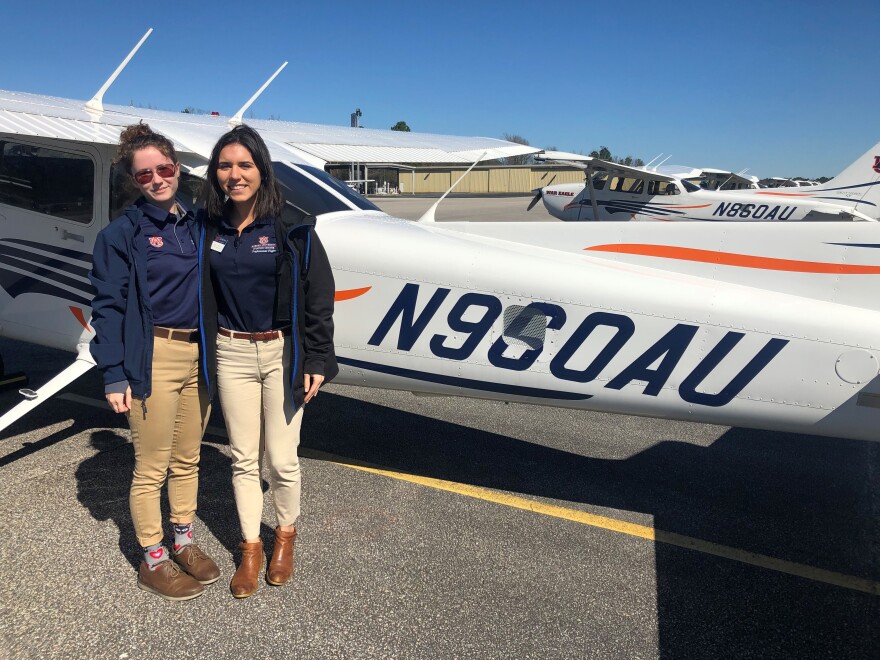The helicopter crash that killed basketball star Kobe Bryant and eight others in January has spurred action by Congress. This month, lawmakers introduced a bill long requested by regulators that would require new safety standards and equipment such as terrain-awareness systems. The pilot in that crash flew into worsening weather conditions and lost control.
But the proposed legislative fixes won't solve what is a familiar problem in the aviation industry — and something it's wrestled with for decades: getting pilots to turn around or divert when the path ahead starts to look bad.
Aviation is not inherently dangerous — but it is unforgiving in terms of neglect or carelessness. That's a rough quote attributed to a British captain from the 1930s. And it's true. Little mistakes can snowball into serious problems. But of all the modes of transportation, pilots undergo the most training.
On a training flight in Alabama, Elizabeth White eased the throttle forward of her Cessna 172 and the plane lifted off into a clear, blue sky. She's an Auburn University student in the professional flight program and flying this day, with instructor Megan Brown, "Why don't you give me a right turn, to that lonely water tower out there." White turned the yoke and the plane banked swiftly. Later the duo would practice recovery from aerodynamic stalls, slow-flight and visual navigation.
White is already a private pilot with her instrument rating and working now on becoming an instructor. It takes hundreds of hours of flight experience and ground-based training to get to this point. Most airlines won't hire a pilot with fewer than 1,500 hours.
Brown said part of her challenge, as an instructor, is ensuring students remember all this training, years later. "As pilots get older, we tend to get comfortable and, kind of think, oh, yeah, it's no big deal," Brown said, "What you got to be aware of is the minute you start feeling wrong about something, you've got to stop the flight."

And that, it appears, is what the pilot of the Kobe Bryant crash did not do.
It's a known problem in aviation called 'get there itis' — meaning pilots focus on getting to their destination when that's not always the safest outcome. "Pilots, in general, tend to be goal-oriented people," said Richard McSpadden, executive director of the Air Safety Institute with the Aircraft Owners and Pilots Association.
He said pilots often feel pressure to complete a flight. "We think part of it is either consciously or subconsciously, when a pilot takes off in a desire to go fly somewhere, that goal is set in their mind in what's in their mind as I need to achieve my goal and get to my destination."
The National Transportation Safety Board investigates aviation accidents including the Kobe Bryant crash — but doesn't keep statistics on how often 'get there itis' factors in accidents. NTSB reports — going back decades — are filled with instances of pilots continuing on in deteriorating weather. (Last week, the NTSB released 1,700 pages of its investigation so far. The reports indicate Ara Zobayan, the pilot, might have been disoriented in fog. A final accident report isn't expected for months.)
It's a particular issue in general aviation and some on-demand charter operations.
The helicopter industry is working to prevent accidents like these. James Viola, president of Helicopter Association International, points to his organization's safety campaign called "Land and Live" which is designed to remind pilots to be smart and safe. "If we're flying along and something's just not going right — that we should land and reassess the situation. Airplanes can't do that. We'd like to see helicopters use that 'land and live' program a lot more."
Viola said a safer option is landing in a field or a road to wait for the weather to improve or calling a taxi to get passengers to their destination.
It's not clear why pilots press on and crash rather than diverting to fly another day.
Aviation is the safest kind of travel — by far. But as accidents like the Kobe Bryant crash show — it's easy to make mistakes and the margin of error can be very small. And the psychological issues of flying aren't something that can be easily fixed by legislation.
Copyright 2023 NPR. To see more, visit https://www.npr.org.




